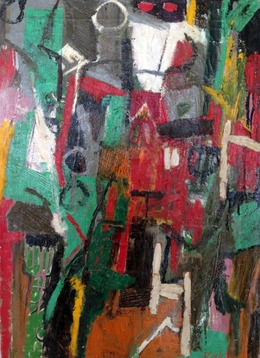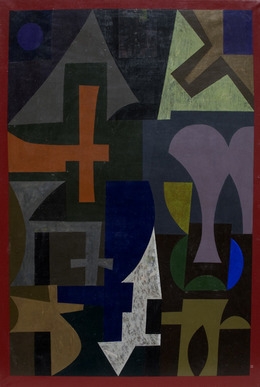In the early 1950s, Ajijic was a center for art classes marketed primarily in the U.S. The classes and workshops attracted a wide diversity of painters of equally varied artistic backgrounds.
Several of the young students studying in Ajijic at that time went on to forge stellar careers in the art world. We looked at the extraordinary work of Barbara Zacheisz Elstob in a previous post.
In this post we focus on Jorge Fick. According to the biography of Fick submitted to askart.com by his widow, Judy Perlman, Fick attended a “Mexican Art school Ajijic, Guadalajara” in 1951.
Born George Fick in Detroit, Michigan, in 1932, Fick changed his first name to its Hispanic version—Jorge—following his time studying art in Ajijic in 1951 and in deference to Hispanic culture.
Prior to studying in Ajijic, Fick attended Cass Technical School, a public trade school in Detroit, between 1947 and 1950, and studied at the city’s Society of Arts and Crafts from 1950 to 1951.
It is unclear how he came to study in Ajijic but it certainly had a profound impact on his life as an artist.
After Ajijic, Fick studied from 1952 to 1955 at Black Mountain College, whose faculty, at one time or another, included such artistic luminaries as Josef Albers, Anni Albers, John Cage, Merce Cunningham, Buckminster Fuller and Aaron Siskind.
His decision to study at Black Mountain College immediately after Ajijic is especially interesting and may well have been prompted by one of his teachers in Mexico. The art workshops in Ajijic were led by local artist Ernesto Butterlin, ably assisted by “Nick” Muzenic. Alexander Nicolas Muzenic (1919-1976) had studied at Black Mountain College, under the legendary Josef Albers, from about 1945 to 1948 before moving to Ajijic. Albers and his wife, Anni, subsequently visited the village for a few days—to reconnect with their former student—and this may have coincided with Fick’s study visit. It is tempting to speculate that Muzenic, perhaps with help from Albers, persuaded Fick to attend Black Mountain College.

Jorge Fick. 1952. Where War Is. Credit: Eric Firestone Gallery
In 1953, Fick was staying in New York when he lent a suit to poet and author Dylan Thomas, who wore it three days before he died. The suit, later returned to Fick, is now proudly displayed in the Dylan Thomas Centre in Swansea, Wales.
Fick’s tutors at Black Mountain College were Franz Kline, Philip Guston, Jack Tworkov, Joseph Fiore, Esteban Vicente (collage) and Peter Voulkos (pottery). He thrived in the liberal artistic atmosphere of the college and graduated in 1955 with a Bachelor’s of Fine Arts degree. After graduating, Fick shared a studio in New York for some time with Kline, his college mentor. Kline had previously invited Fick to exhibit at the Stable Gallery and had encouraged him to explore abstract expressionism.

Jorge Fick. 1965. Zoroaster.
In 1958, Fick moved to Santa Fe, New Mexico. He spent the remainder of his life (he died in 2004) in New Mexico, dividing his time between Santa Fe and Taos. He made significant contributions to the art scene in New Mexico. In addition to developing his own painting techniques, including large-scale “Pod” oil paintings that combine abstraction, Pop art and cartoons, Fick also printed Eliot Porter’s environmental photographs (1962-1968), acted as a color consultant to architect-designer, Alexander Girard, responsible for the rebrand of Braniff Airlines, and collaborated with Cynthia Homire on glazed stoneware pieces.
Between 1969 and 1983, Fick ran “The Fickery” Gallery and Art Space at 720 Canyon Road in Santa Fe, New Mexico.
Fick’s paintings won numerous awards. His work featured in numerous solo and group shows including the Museum of New Mexico Biennial (1971, 1998); the International Folk Art Museum in Santa Fe (1971, 1972); Colorado Springs Fine Arts Museum (1972); Roswell Museum (1972); Taos Artist Association Annual (1994); St. John’s College, Santa Fe (solo show, 1994); Albuquerque Museum (1996).
Examples of Fick’s paintings can be seen in many important public collections, including the Whitney Museum of American Art, New York; Harwood Museum, Taos; New Mexico Museum of Art, Santa Fe; Phoenix Art Museum; Roswell Museum; Smith College Museum of Art, Northampton, Massachusetts.
[Note: Fick’s attendance at a “Mexican Art school Ajijic, Guadalajara” in 1951 may not be quite right. Gerald van de Wiele, who accompanied his good friend Fick to Mexico in 1951, told me that Fick had not previously been in Ajijic, that they arrived in late November or early December 1951, and that their trip did not involve any formal art classes. There are no records of any winter art classes in Ajijic at that time.]
Sources
- Eric Firestone Gallery. Biography of Jorge Fick
- Everette Hatcher III. 2011. The Artists, Poets and Professors of Black Mountain College, Part 3 artist Jorge Fick.
- Judy Perlman. Biography of Jorge Fick submitted to askart.com
Comments, corrections or additional material related to any of the writers and artists featured in our series of mini-bios are welcome. Please use the comments feature at the bottom of individual posts, or email us.
Tony Burton’s books include “Lake Chapala: A Postcard History” (2022), “Foreign Footprints in Ajijic” (2022), “If Walls Could Talk: Chapala’s historic buildings and their former occupants” (2020), (available in translation as “Si Las Paredes Hablaran”), “Mexican Kaleidoscope” (2016), and “Lake Chapala Through the Ages” (2008).